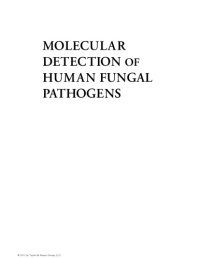
Ebook: Molecular Detection of Human Fungal Pathogens
Author: Dongyou Liu
The large number of molecular protocols available creates a dilemma for those attempting to adopt the most appropriate for streamlined identification and detection of fungal pathogens of interest. Molecular Detection of Human Fungal Pathogens provides a reliable and comprehensive resource relating the molecular detection and identification of major human fungal pathogens. This volume contains expert contributions Read more...
Content: Front Cover; Contents; Preface; Editor; Contributors; Chapter 1 --
Introductory Remarks; Chapter 2 --
Alternaria; Chapter 3 --
Aureobasidium; Chapter 4 --
Bipolaris and Drechslera; Chapter 5 --
Botryomyces; Chapter 6 --
Botryosphaeria and Lasiodiplodia; Chapter 7 --
Corynespora; Chapter 8 --
Curvularia; Chapter 9 --
Exserohilum; Chapter 10 --
Fusicoccum and Scytalidium; Chapter 11 --
Hortaea; Chapter 12 --
Leptosphaeria; Chapter 13 --
Macrophomina; Chapter 14 --
Madurella; Chapter 15 --
Neodeightonia; Chapter 16 --
Phoma and Phomopsis; Chapter 17 --
Piedraia; Chapter 18 --
Pyrenochaeta Chapter 19 --
RamichloridiumChapter 20 --
Ulocladium; Chapter 21 --
Acrophialophora; Chapter 22 --
Arthrographis; Chapter 23 --
Aspergillus; Chapter 24 --
Blastomyces; Chapter 25 --
Chrysosporium; Chapter 26 --
Cladophialophora; Chapter 27 --
Coccidioides; Chapter 28 --
Cyphellophora; Chapter 29 --
Emmonsia; Chapter 30 --
Epidermophyton; Chapter 31 --
Exophiala; Chapter 32 --
Fonsecaea; Chapter 33 --
Histoplasma; Chapter 34 --
Lacazia; Chapter 35 --
Lecythophora; Chapter 36 --
Microsporum*; Chapter 37 --
Myriodontium; Chapter 38 --
Onychocola; Chapter 39 --
Paecilomyces; Chapter 40 --
Paracoccidioides Chapter 41 --
Penicillium: Mycoses and MycotoxinosesChapter 42 --
Phialophora; Chapter 43 --
Rhinocladiella; Chapter 44 --
Trichophyton; Chapter 45 --
Veronaea; Chapter 46 --
Acremonium; Chapter 47 --
Beauveria; Chapter 48 --
Chaetomium; Chapter 49 --
Colletotrichum; Chapter 50 --
Cylindrocarpon; Chapter 51 --
Fusarium; Chapter 52 --
Microascus, Including Scopulariopsis; Chapter 53 --
Myceliophthora and Thielavia; Chapter 54 --
Neocosmosporas; Chapter 55 --
Ochroconis; Chapter 56 --
Phaeoacremonium; Chapter 57 --
Phialemonium; Chapter 58 --
Pseudallescheria and Scedosporium; Chapter 59 --
Sarcopodium Chapter 60 --
Sporothrix and SporotrichosisChapter 61 --
Stachybotrys; Chapter 62 --
Trichoderma; Chapter 63 --
Verticillium; Chapter 64 --
Candida; Chapter 65 --
Debaryomyces; Chapter 66 --
Geotrichum; Chapter 67 --
Kluyveromyces; Chapter 68 --
Pichia and Kodamaea; Chapter 69 --
Pneumocystis; Chapter 70 --
Saccharomyces; Chapter 71 --
Coprinopsis and Hormographiella; Chapter 72 --
Cryptococcus; Chapter 73 --
Malassezia; Chapter 74 --
Rhodotorula; Chapter 75 --
Schizophyllum; Chapter 76 --
Sporobolomyces; Chapter 77 --
Trichosporon; Chapter 78 --
Ustilago and Pseudozyma; Chapter 79 --
Wallemia Chapter 80 --
ApophysomycesChapter 81 --
Cokeromyces; Chapter 82 --
Cunninghamella; Chapter 83 --
Entomophthorales; Chapter 84 --
Lichtheimia (Absidia-Like Fungi); Chapter 85 --
Mortierella; Chapter 86 --
Mucor; Chapter 87 --
Rhizopus; Chapter 88 --
Rhizomucor; Chapter 89 --
Saksenaea; Chapter 90 --
Syncephalastrum; Chapter 91 --
Anncaliia (Brachiola); Chapter 92 --
Encephalitozoon; Chapter 93 --
Enterocytozoon; Chapter 94 --
Nosema, Vittaforma, and Microsporidium; Chapter 95 --
Pleistophora and Trachipleistophora; Chapter 96 --
Pythium; Chapter 97 --
Prototheca; Chapter 98 --
Rhinosporidium Chapter 99 --
Nucleic Acid-Based Panfungal Detection
Abstract: The large number of molecular protocols available creates a dilemma for those attempting to adopt the most appropriate for streamlined identification and detection of fungal pathogens of interest. Molecular Detection of Human Fungal Pathogens provides a reliable and comprehensive resource relating the molecular detection and identification of major human fungal pathogens. This volume contains expert contributions from international mycologists involved in fungal pathogen research and diagnosis. Following a similar format throughout, each chapter comprises: A brief review of the classification
The large number of molecular protocols available creates a dilemma for those attempting to adopt the most appropriate for streamlined identification and detection of fungal pathogens of interest. Molecular Detection of Human Fungal Pathogens provides a reliable and comprehensive resource relating the molecular detection and identification of major human fungal pathogens. This volume contains expert contributions Read more...